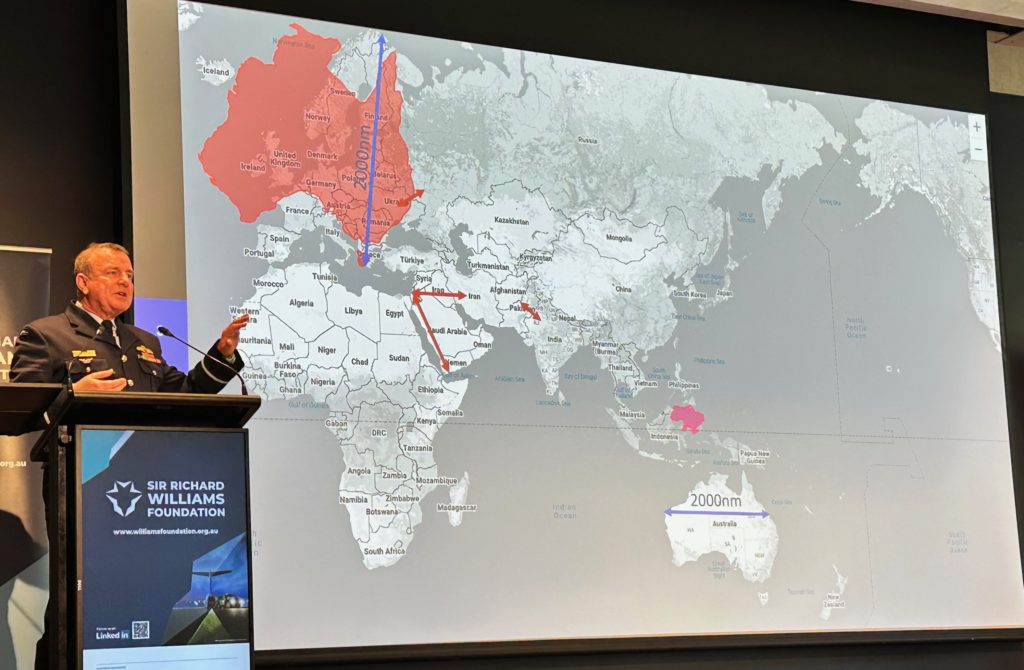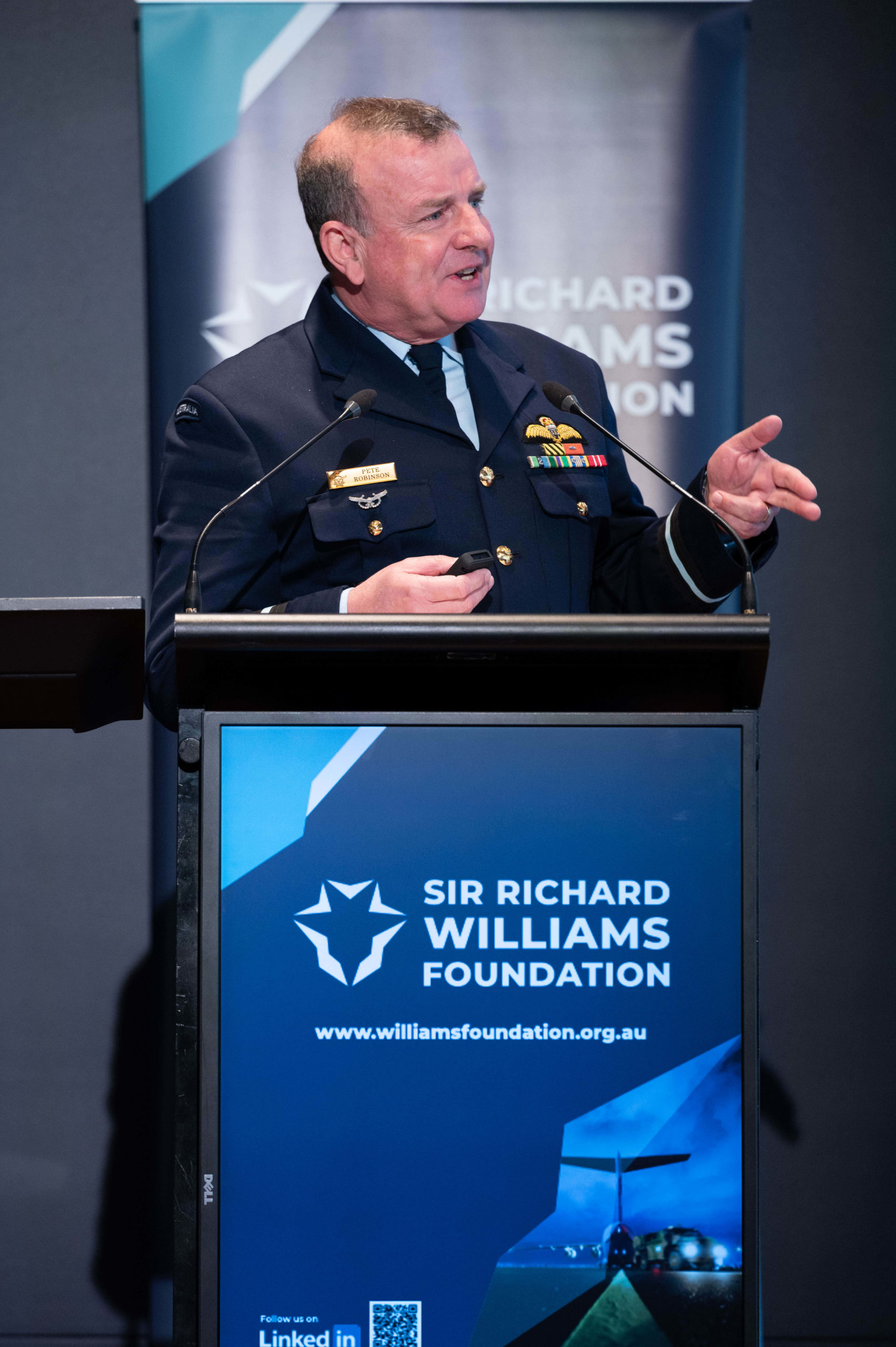Australia’s Air Power: Ready for Tonight, Preparing for Tomorrow
The strategic landscape facing Australia has fundamentally shifted. For the first time since World War II, the Australian Defence Force is genuinely preparing to defend the homeland rather than simply contributing to distant coalitions.
This stark reality was laid bare in a recent presentation by Air Commodore Peter Robinson, Commander Air Combat Group, to the Sir Richard Williams Foundation, where he outlined the Royal Australian Air Force’s current capabilities, limitations, and the unique challenges of potential conflict in the Indo-Pacific theater.
The New Strategic Reality
Robinson’s presentation began with an uncomfortable truth: the probability of Australia being drawn into conflict is higher now than at any point in recent decades. This assessment reflects a broader strategic shift that has moved Australia from a mindset of expeditionary operations supporting allies to one of homeland defence and regional deterrence.
The “fight tonight” philosophy that Robinson espouses represents a fundamental change in military thinking. Rather than planning for future capabilities or waiting for ideal conditions, it demands readiness with current assets against existing threats. This approach acknowledges that while defence planners may prefer to wait for next-generation systems or perfect training conditions, adversaries operate on their own timelines.
The urgency of this perspective is underscored by recent conflicts worldwide. Robinson pointed to the India-Pakistan engagement as an example of how “getting night one right” can set the tone for an entire conflict. The Pakistani air force’s effective performance on the opening night, despite not changing the strategic balance between the nations, demonstrated the importance of seamless integration between training, equipment, and command structures from the conflict’s outset.
Geographic Imperatives of the Indo-Pacific
Perhaps no factor shapes Australia’s defence challenge more than geography. Robinson’s presentation included a striking comparison: the 2,000-mile span from Perth to Cairns equals the distance from northern Finland to Greece – essentially the entire NATO front line. Yet where Europe offers dense populations, extensive infrastructure, and multiple allied nations within close proximity, Australia faces vast oceanic distances with scattered island chains and limited friendly bases.

This “tyranny of distance” creates both advantages and disadvantages for Australian defence planning. The vast spaces provide natural barriers and complicate enemy planning, but they also stretch Australian forces thin and create enormous logistical challenges. Unlike European theaters where reinforcements might arrive within hours, the Indo-Pacific demands self-reliance and forward positioning.
The strategic implications are profound. Rather than defending at Australia’s borders, effective defence requires projecting power far forward into the region. As Robinson emphasized, it’s preferable to “kill the ship before it launches missiles” than to intercept those missiles after launch. This forward defence concept demands not only advanced capabilities but also extensive regional partnerships and basing arrangements.
The Alliance Imperative
Robinson’s presentation highlighted an often underappreciated aspect of modern air power: the critical importance of relationships and trust-building at tactical levels. The RAAF maintains an extensive exercise program across the Indo-Pacific, from Thailand and Indonesia to Japan and the Philippines. These engagements serve multiple purposes beyond simple training.
• First, they build operational familiarity with regional air forces, creating the foundation for potential coalition operations.
• Second, they demonstrate Australian commitment to regional security while providing deterrent effects.
• Third, they offer practical experience in operating from austere or unfamiliar bases – a capability that may prove essential in conflict.
The depth of integration with U.S. forces represents a particular strategic asset. Exercises like Red Flag and Green Flag provide Australian aircrew with exposure to high-end combat scenarios at classification levels that offer genuine insight into potential regional conflicts. This integration extends beyond simple interoperability to shared intelligence, planning, and operational concepts.
Recent developments, such as taking weapons into Southeast Asia for the first time in decades during Exercise Cope West in the Philippines, represent significant policy and operational milestones. Such exercises test not only tactical procedures but also the diplomatic and logistical frameworks necessary for forward operations.
Technological Transformation
The RAAF has undergone dramatic modernization over the past decade, transitioning from platforms that had served since the 1970s and 1980s to cutting-edge systems. The replacement of F-111s with Super Hornets, introduction of EA-18G Growlers, and transition to F-35 Lightning II aircraft represents one of the most comprehensive air force modernizations attempted by any nation.
This transformation has created capabilities that Robinson describes as exceptional. The Growler electronic warfare aircraft, in particular, has “far outshone what we thought that one platform could have done.” The retention of Super Hornets until 2040, originally planned for much shorter service, reflects their continued relevance as strike platforms capable of carrying weapons that the F-35 cannot accommodate, including hypersonic attack cruise missiles.
However, Robinson emphasized that platform acquisition represents only the beginning of capability development. Modern aircraft undergo continuous spiral upgrades, with new software and hardware packages appearing approximately every two years. The pace of these upgrades is not determined by convenient scheduling but by adversary capabilities and threats.
The Weapons Equation
Perhaps no aspect of “fight tonight” readiness is more straightforward than weapons stockpiles. Robinson’s formula is deliberately stark: “start with a ludicrous number, double it and add a zero, and that’s about right.” This reflects the reality that modern conflicts consume precision weapons at rates that consistently surprise planners.
The RAAF currently possesses what Robinson describes as “exquisite weapons” capable of engaging tier-one maritime and land targets throughout the region. The service has demonstrated this capability through live-fire exercises, including the successful employment of LRASM (Long Range Anti-Ship Missile) from Super Hornets. The addition of hypersonic attack cruise missiles adds a capability that Robinson suggests will “put our adversaries on the back foot” due to the extended ranges and speeds involved.
However, the weapons challenge extends beyond current stockpiles to production capacity and resupply during conflict. The ongoing war in Ukraine has demonstrated how quickly precision weapons can be exhausted and how difficult rapid replenishment can prove, even for major military powers.
Operational Art and Integration
Modern air warfare extends far beyond individual platforms and weapons to encompass “operational art” or the integration of multiple capabilities to achieve strategic objectives. The RAAF’s Air Operations Center represents the nerve center for this integration, bringing together not only air assets but capabilities across all domains and government agencies.
This integration reflects a fundamental shift from traditional air power concepts focused on air-to-air combat and close air support to multi-domain operations incorporating cyber, space, electronic warfare, and information operations. The goal is to create asymmetric effects that leverage Australia’s technological advantages while mitigating numerical disadvantages.
The development of collaborative combat aircraft, advanced unmanned systems that can operate alongside manned fighters, represents the next evolution in this integration. These systems promise to provide additional mass and capability while reducing risk to highly trained aircrew.
Sustainment Challenges
While confident about immediate readiness, Robinson acknowledged significant concerns about sustained operations. The transition from “fight tonight” to “fight for weeks” introduces challenges around logistics, maintenance, and force regeneration that currently lack clear solutions.
The presentation highlighted several specific concerns. Fuel distribution represents a critical vulnerability, leading to investments in mobile refueling systems and distributed storage to reduce dependence on large, vulnerable fuel farms. Base defence and passive protection measures, including hardened aircraft shelters and dispersed operations, seek to maintain capability even under attack.
Perhaps most challenging is the human dimension of sustained operations. The RAAF has invested heavily in developing what Robinson terms “the world’s best tacticians” through the Air Warfare Instructor program. These highly skilled personnel represent irreplaceable assets whose loss would significantly degrade capabilities.
Emerging Threats and Unknown Unknowns
Robinson’s presentation candidly addressed several areas of concern that extend beyond traditional air warfare. Counter-drone capabilities represent a “known known,” everyone recognizes the threat posed by small unmanned systems, but developing effective countermeasures remains challenging.
Cyber warfare represents a “known unknown” for everyone expects cyber attacks, but their precise effects and the most effective responses remain unclear. The integration of cyber effects with kinetic operations could fundamentally alter the character of conflict in ways that are difficult to predict or prepare for.
Information warfare, particularly targeting military families through social media, represents another emerging threat. The psychological impact of false reports about casualties or operational failures could significantly affect force morale and effectiveness.
Force Protection and Resilience
The presentation emphasized that protecting forces extends beyond traditional force protection measures to encompass information security, operational security, and family support systems. Modern conflicts increasingly blur the lines between military and civilian targets, making comprehensive protection more challenging.
The RAAF’s approach to resilience includes both technical measures, such as hardened communications and distributed operations, and human measures, such as support systems for military families. The goal is to maintain operational effectiveness even under sustained attack or pressure.
Leadership and Human Capital
Robinson concluded his presentation by emphasizing the exceptional quality and dedication of Australian Defence Force personnel. He noted that current service members demonstrate “a really clear sense of purpose for the environment that we’re in, more so than I think I’ve ever seen in my career.”
This human dimension often receives less attention than platforms and weapons but may prove decisive in conflict. The transition of the RAAF over the past decade, accomplished without additional personnel, demonstrates the adaptability and commitment of the force. However, it also highlights the importance of preserving this human capital through appropriate pacing of operations and training.
Conclusion: Ready but Realistic
Air Commodore Robinson’s assessment presents a force that is genuinely ready for immediate challenges but realistic about limitations. The RAAF has successfully modernized its platforms, developed advanced operational concepts, and built strong regional partnerships. However, questions remain about sustained operations, emerging threats, and the broader industrial base required for prolonged conflict.
The “fight tonight” philosophy represents more than military planning . It reflects Australia’s strategic reality in an increasingly contested Indo-Pacific. While hoping for continued peace, the RAAF is preparing for scenarios that seemed unthinkable just a decade ago. The quality of that preparation, and the realism about its limitations, may ultimately determine Australia’s security in an uncertain future.
The featured image: Air Commodore Peter Robinson, Commander Air Combat Group presenting to the seminar.

